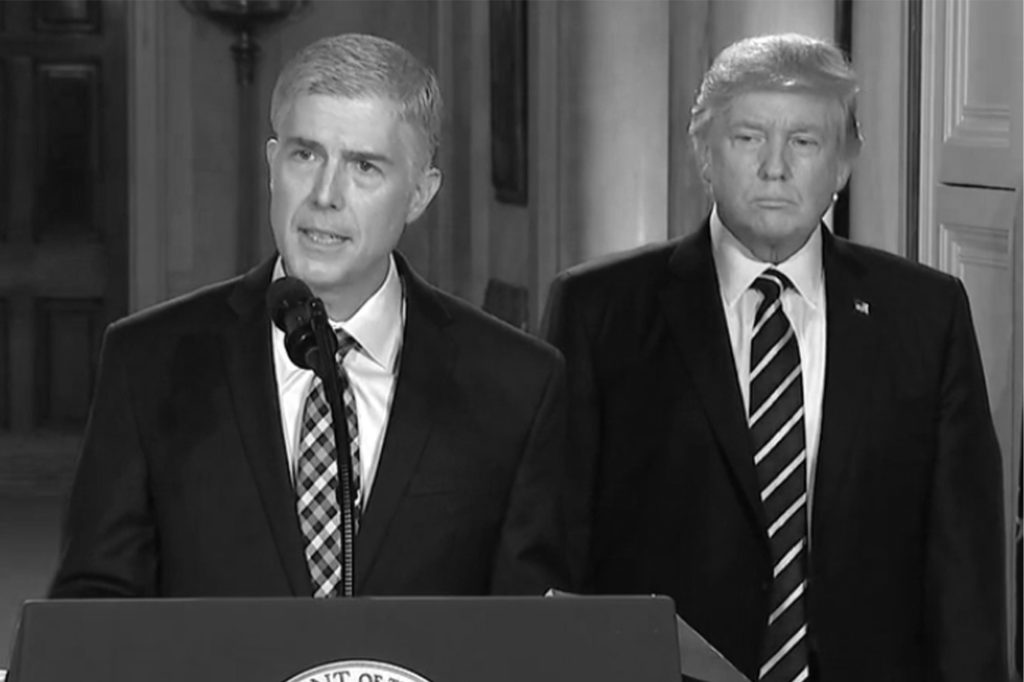Does Title VII of the Civil Rights Act of 1964, which prohibits sex discrimination in employment, require American employers to be effectively sex-blind?
Last week, in a blockbuster decision, the Supreme Court endorsed the truly radical notion that an employer unlawfully discriminates against a person because of sex whenever that person’s sex is a but-for cause of the employer’s decision to impose a burden or withhold a benefit. In three cases, consolidated under Bostock v. Clayton County, the Court endorsed what it called “a straightforward rule” that prohibited any adverse employment decisions that are “based in part” on the person’s sex.
By the decision, all sex-conscious policies that adversely affect an individual are unlawful. Although the immediate decision concerned only sexual-orientation and gender-identity discrimination, the Court’s holding has a far more expansive scope. Many customary practices are now probably illegal, including sex-specific norms of attire, restrooms, pronouns, and other forms of address. Likewise, religious and other conservative employers may no longer reserve spousal benefits to marriage according to its once-universal male-female meaning. The potential cases are countless, the threat to individual liberty severe—but the Court blithely explained that such matters are “for future cases.”
Such an outcome, of course, is entirely foreign to the original understanding of those who adopted the Civil Rights Act. In fact, decades passed before any court read Title VII to require such sex blindness.
Start your day with Public Discourse
Sign up and get our daily essays sent straight to your inbox.But Justice Gorsuch, writing for the Court majority, said that the “plain text” of the law compelled the result. Relying on a sharp distinction between the law’s textual meaning and Congress’s expectations or “imagination,” he contended that the Act expressly bars all “sex” discrimination and thus all sex-specific policies—regardless of congressional intent. There are no “exceptions to [this] broad rule.” Further, he claimed, this “no-exception” reading “is exactly how this Court has always approached Title VII.”
We think, however, that this textualism is both bad law and terrible history.
Lawmaking versus Speaking in Tongues
It’s bad law—for if this interpretation is correct, then Title VII fails a basic test of all true law. As jurists have long acknowledged, a legislator’s utterance is not law unless it is promulgated and thus known “to the people who are to obey it,” as Blackstone wrote.
If Congress was indeed uttering words that they (and American employers) did not understand—with unintentional but revolutionary effects on society—then Congress was not legislating but, instead, “speaking in tongues with none there to interpret.” Such noise-making, whatever its value, is not lawmaking.
The Legal Meaning of Adverse Sex Discrimination in 1964
This textualism is also terrible history, betraying serious historical blindness.
Justice Gorsuch utterly ignored the relevant and compelling evidence as to the original legal meaning of Title VII.
Justice Gorsuch utterly ignored the relevant and compelling evidence as to the original legal meaning of Title VII. As Justice Alito explained (with apparent reliance on the amicus brief we filed on behalf of the American Public Philosophy Institute), the norm against sex-discrimination had, by 1964, already acquired a substantial legal meaning that precluded any radical sex-blindness mandate.
For generations, American law had incorporated various rules against sex discrimination—with Western states leading the way. By the late nineteenth century, Kansas, Wyoming, and Washington had constitutionally prohibited sex discrimination in public education. Wyoming and Utah had constitutionally prohibited sex discrimination in the regulation of suffrage and other political rights. And by the early twentieth century, state authorities in California, Utah, Wyoming, Colorado, and Michigan had moved in various ways to prohibit sex discrimination in certain professions (e.g. law) or employment in general.
Throughout all these decades, no legal authority ever entertained the notion that to ban sex discrimination meant to ban all sex-specific norms. To cite just one example, beginning with its 1859 constitution, Kansas had prohibited sex discrimination in its public schools; for a century, there is no record that anyone even suggested that this rule might ban sex-specific changing rooms or modes of address like “ma’am” and “sir.”
Moreover, bans on sex discrimination proliferated in federal law throughout the twentieth century. In the landmark Immigration and Nationality Act of 1952, for instance, Congress prohibited the denial or abridgment of naturalization “because of race or sex.” In 1965, just a year after adopting Title VII, Congress extended this rule to immigration as well. And there is no record of anyone even suggesting some conflict between this rule and the contemporaneous sexual-orientation discrimination by immigration officials.
But of greatest relevance here is the fuller extension of the anti-sex-discrimination norm to public and private employment. After World War II, equal pay acts multiplied in both American and international law—leading to Congress’s near-unanimous adoption of the Equal Pay Act in 1963.
Perhaps most notably, in 1948, the Universal Declaration of Human Rights (UDHR) stipulated: “Everyone is entitled to all the rights and freedoms set forth in this Declaration, without distinction of any kind, such as race, color, sex. . . .” In 1958, just six years before Title VII, the International Labour Organization (ILO) declared that “discrimination constitutes a violation of rights enunciated by the [UDHR]” and recommended that nations adopt a bar on public and private employment discrimination, including discrimination “made on the basis of race, colour, sex, religion, political opinion, national extraction or social origin.” Forty-six countries (though not the United States) ratified the ILO treaty between 1958 and 1964.
Yet throughout all this time, there is no record of any party ever contending—let alone any authority concluding—that these comprehensive anti-sex-discrimination rules precluded the adoption of customary sex-specific rules. To the contrary, some of the same legislators that barred sex discrimination simultaneously adopted such sex-specific norms. The UDHR, for instance, both affirmed the right of everyone to enjoy all the rights listed “without distinction of . . . sex,” and, where affirming the “right to marry and found a family,” simultaneously indicated that marriage was the union of male and female.
Congress’s alleged failure of “imagination” is itself imaginary. Congress and our fellow citizens had good reason to know that the law’s existing bar to sex discrimination—as extended (not invented) to American employers nationwide—in no way would preclude the virtually universal sex-specific customs as to clothing, modes of address, the meaning of marriage, etc.
The historical evidence on this point is entirely dispositive of the original legal meaning of sex discrimination. Congress never mandated sex-blindness, whether intentionally or otherwise. Yet, throughout his lengthy opinion, Justice Gorsuch failed entirely to address this compelling evidence of original meaning—some of which Justice Alito presented over several pages.
Congress never mandated sex-blindness, whether intentionally or otherwise. Yet, throughout his lengthy opinion, Justice Gorsuch failed entirely to address this compelling evidence of original meaning—some of which Justice Alito presented over several pages.
Which Sex Distinctions Are Permissible?
So how did Americans in 1964 draw a line between permissible and impermissible sex-conscious policies? Which sex distinctions counted as unlawful sex discrimination?
The answer is twofold and can be found in the meaning of the verb “to discriminate.” First, as many have noted, discrimination referred to unequal treatment. Thus, as defined in the ILO Convention and elsewhere, sex discrimination occurs only when there is impairment of “equality of opportunity” to men and women. The traditional rules designating separate restrooms or defining marriage do not obstruct equal opportunity, and may, in fact, promote such opportunity. But to exclude one sex from an occupation does impede this equality.
Second, as we pointed out in our brief, “to discriminate” meant only to affirmatively “make a discrimination.” The law barred employers from affirmatively imposing a distinction but did not require them to oppose all prior distinctions. Where a sex distinction is made by something prior to employment markets, such as biology or a genuine ius gentium, a deep custom adopted by and for both sexes, an employer’s mere acceptance of this distinction was not the employer’s discrimination. For instance, employers make a discrimination when they hire only males as truck drivers. But employers merely accept a distinction when they incorporate the prevailing custom of separate restrooms for men and women. This custom has long been adopted by both sexes for their mutual benefit.
Perhaps another analogy would be helpful. Suppose a lawmaker passed a law prohibiting employers from making a dress code and discriminating against the noncompliant. Would such a law preclude an employer from enforcing the customary norm requiring minimal clothing (the ius gentium that persons conceal the sex organs)? Of course not. The employer is not affirmatively making a discrimination but simply accepting a standard given by the ius gentium—an authority far higher and older than mere employment markets.
This understanding—this distinction—prevailed when the Civil Rights Act was adopted. As future Justice Ruth Bader Ginsburg explained in her famous brief in Reed v. Reed, sex discrimination does not occur where a sex-specific practice reflects genuine “biological differences” or some “basic interest shared by both sexes,” such as “personal privacy.” Consequently, she derided the alleged threat to separate restrooms and college dormitories as a mere “canard.”
Title VII and the Court’s Affirmative Action Jurisprudence
Justice Gorsuch’s opinion not only ignores but rewrites history. He asserts that a literalist, no-exception reading “is exactly how this Court has always approached Title VII.”
The claim is false. The falsehood is knowable to anyone remotely familiar with American employment law.
In its affirmative-action jurisprudence, the Supreme Court has expressly rejected a literalist, no-exception reading of the Civil Rights Act. In United Steelworkers v. Weber, a highly publicized and controversial decision, the Supreme Court held that a literal construction of Title VII was improper, for “a thing may be within the letter of the statute and yet not within the statute, because not within its spirit, nor within the intention of its makers.” Accordingly, in some cases, naked racial preferences are lawful. The dissenters in the case (future Chief Justice Rehnquist and Chief Justice Burger) were apoplectic. They accused the majority of Orwellian perversion of language, by confusing “some” with all, and particularly by inserting an exception into a law that prohibited all race discrimination.
Weber’s expressly anti-textualist decision remains the de facto law of the land. As the Equal Employment Opportunity Commission still insists, Weber rightly upheld discriminatory preferences—despite “what appears to be a conflict [with] the statutory prohibition against considering race, sex, and national origin in making employment decisions.”
Knowing this history is easy—and every member of the Court had reason to know of it. Yet Justice Gorsuch and all his colleagues preserved a scrupulous silence. Something obstructed them from seeing and saying the obvious: that the majority’s (putative) textualism in Bostock is utterly irreconcilable with the majority’s anti-textualism in Weber.
A Coherent Conservative Reading of Title VII?
Even the conservatives hesitated to bring up Weber. Perhaps they were reluctant to suggest any disavowal of Justice Rehnquist’s literalist, “color-blind” reading of Title VII. Perhaps they could not see a way to reconcile the color-blind and sex-conscious readings.
The discussion above, however, provides a coherent and true textualist rule: the question is, what was the well-established legal meaning of race and sex discrimination as of 1964? What sort of policies, under the pre-1964 versions of that law were (1) always, (2) never, or (3) sometimes, deemed to constitute such discrimination? As a matter of true originalist-textualist analysis, only the third category gives occasion for judicial clarification or liquidation.
In making sense of the distinct answers, we can look to the meaning of “to discriminate,” discussed above. To discriminate means (1) to deny equal opportunity and/or (2) the imposition of a discrimination—and not merely the acceptance of a distinction made by biology and the ius gentium. Title VII requires race or color-blindness only insofar as race-specific policies qualify as unlawful discrimination—by denying equal opportunity and by originating not in biology or transnational and transracial ius gentium, but in the injustice of American slavery and white supremacy—or in some (over)reaction to the same.
As to affirmative action—we think it probable that all such race-conscious policies violate Title VII. They are not vindicated by the pre-1964 understanding, as evinced in the congressional debates. Further, such policies both effectively deny equal opportunity and are plainly created, and not merely accepted, by employers.
But there may be a few color-specific rules that are not thus discriminatory, for they both foster equal opportunity and reflect distinctions founded in biology and deep custom. One such custom governs our expectations for makeup. A person’s skin tone should guide him or her in the selection of an appropriate shade of foundation. If, however, an employee were to choose to wear foundation suited for a skin tone darker than his or her own, others would deem the choice ridiculous and perhaps very offensive.
Surely, employers may adopt this color-conscious custom by thus prohibiting transracial makeup or blackface at work events, without violating Title VII’s comprehensive ban on race or color discrimination. Indeed, even the most ardent devotee of a “color-blind” society might agree that Title VII permits, and perhaps requires, that employers enforce this color-conscious rule, arising not from racial supremacy or reactions thereto, but to a reasonable custom accepted across racial and national lines.
What’s true of color discrimination is surely true of sex discrimination, though the acceptable sex-conscious policies are far more numerous. Neither the intent nor the letter of the Civil Rights Act, nor the Court’s own jurisprudence compels sex blindness. The judges who have failed to see this truth are blind to legal history.
They are not “woke.” They’re asleep on the job.















